Alienware 18 Gaming Notebook Review
by Dustin Sklavos on September 16, 2013 12:00 PM ESTI'll admit we're getting a pretty solid workout with the NVIDIA GeForce GTX 780M. There are reasons, though. First, the 780M's performance has been very inconsistent since it launched. While some notebooks just needed driver updates (like the Alienware 18), most needed a BIOS update and driver update after the fact. And there's no getting around the fact that the 780M seems to be just plain underperforming. Is part of that due to Haswell? Certainly; for gamers, Haswell as an upgrade over Ivy Bridge is disappointing to say the least. But I suspect there's BIOS and/or driver tweaking still yet to be done to bring the 780M in line with where it really ought to be.
The other reason is that AMD just plain didn't show up to this party. There's a Radeon HD 8970M on the market, but AMD's Enduro is still a bit of a mess, and the 8970M itself is just a rebrand of the 7970M, a chip which already has a hard time competing with the 680M. If I were a betting man I'd expect actual competition to the 780M to materialize sometime in October or November. Hopefully the 780M's issues will have been completely ironed out by then.
Of course, with all that said, the 780M still works pretty well, and NVIDIA's SLI technology is incredibly sound and sturdy. The Alienware 18 boasts dedicated cooling for each GPU and the CPU, and the Intel Core i7-4900MQ should give the two 780Ms plenty of breathing room.
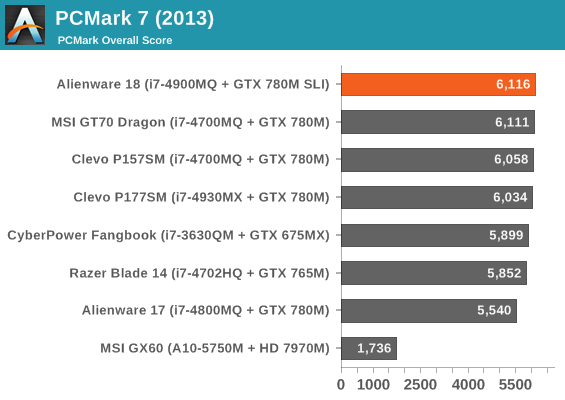
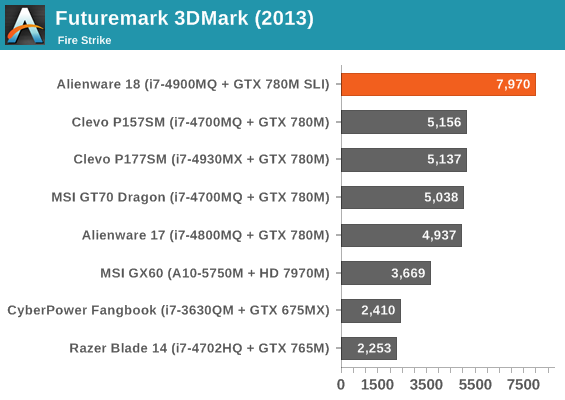
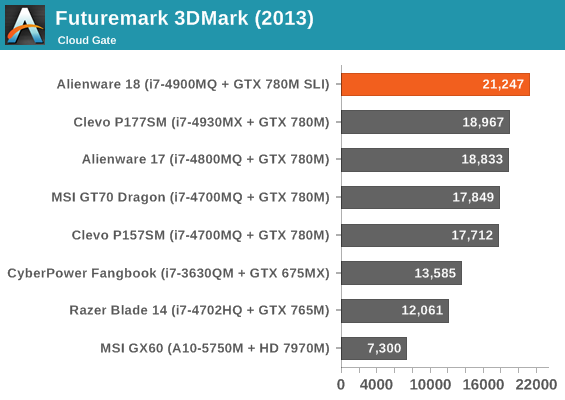
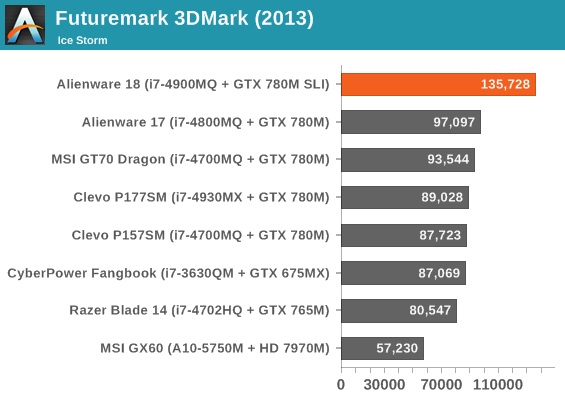
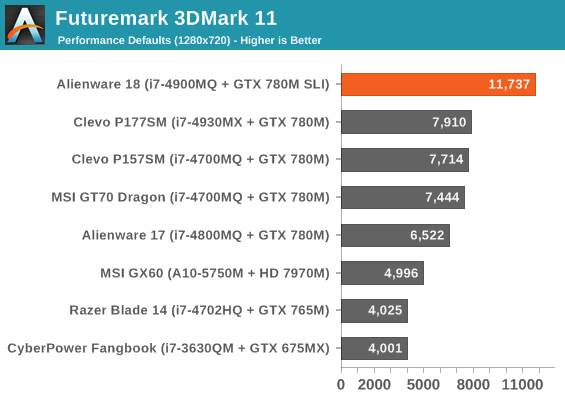
The Futuremarks are as kind to the Alienware 18 as they ought to be. What I want to point out is the PCMark 7 score. The MSI GT70 Dragon we tested is using three SSDs in RAID 0 while the Alienware 18 has to "make do" with a single 512GB (though you can certainly put multiple SSDs into it and stripe them), yet their PCMark 7 scores (a benchmark notoriously SSD friendly) are almost identical. While modern SSDs are hitting bandwidth limitations on SATA, I feel like you'd be hard pressed to really notice a difference with higher throughput in any practical applications.
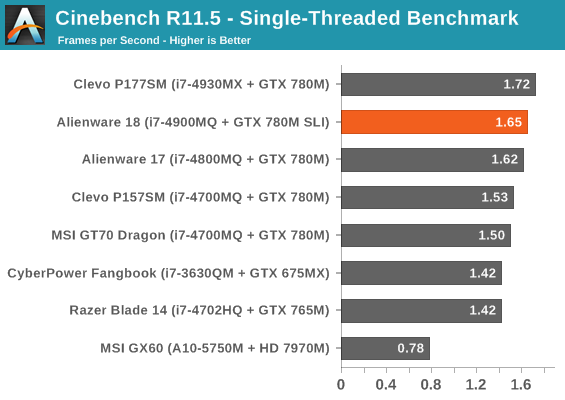
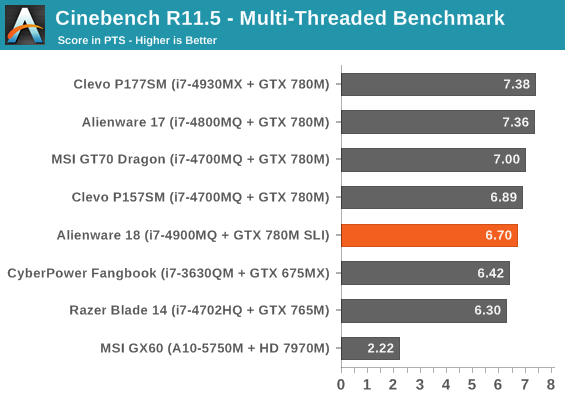
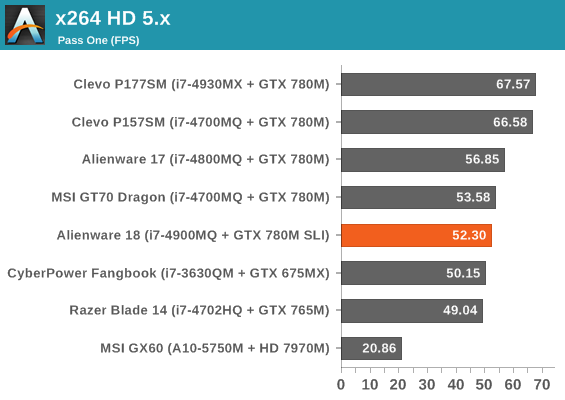
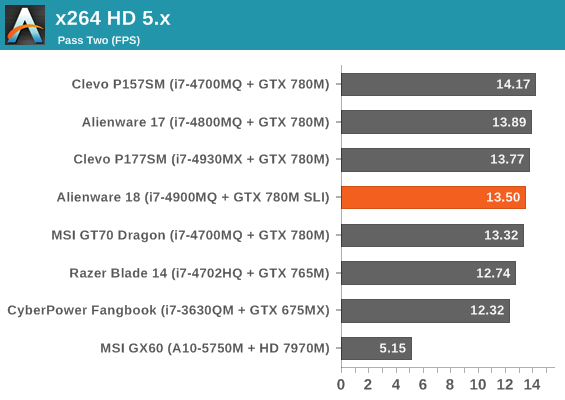
I'd be interested in figuring out why Haswell is underperforming in the Alienware notebooks, though. In our synthetics, the Alienware 17 and now the 18 just aren't stacking up where they ought to be, especially our x264 testing. Performance isn't alarmingly poor, but they're definitely having trouble keeping up with Clevo's Haswell implementations.










60 Comments
View All Comments
DanNeely - Tuesday, September 17, 2013 - link
Considering that Dell didn't have the 780m's in the review model available to order when the article was published due to a supply shortage any argument that begins "Dell ought to be able to source X" is clearly suspect.Notmyusualid - Monday, September 16, 2013 - link
Yes, not far off pal.2133MHz is availabe in sodimm, but runs at a lazy CAS12. That I can do with my 1866MHz sodimm, but I keep it at 1866MHz, and CAS9. I do however have to run it at 1.6V.
Here:
Manufacturer Kingston Technology Company
Manufacturer Part Number KHX21S12P1K2/8
Manufacturer Website Address http://www.kingston.com
Brand Name Kingston
Product Line HyperX PnP
Product Name 8GB 2133MHz DDR3 Non-ECC CL12 SODIMM (Kit of 2) HyperX Plug n Play
Product Type RAM Module
madmilk - Monday, September 16, 2013 - link
DDR3-1600 is fine. The big bandwidth hog is the iGPU, but no one cares about a couple extra percent in iGPU performance on a laptop with discrete graphics.ShieTar - Tuesday, September 17, 2013 - link
I read some German magazines who have the tendency to run gaming benchmarks every year or so, and its been a long time since you could get any relevant performance boost out of higher than normal DDR speeds with an INTEL CPU. All you get from 2400 vs 1600 is about a 2% to 4% boost in performance, if you're lucky.As far as what kind of memory you will need in 5 years, that is total guessing on your part. Game developers will use what is widely available, and with the new generation of gaming consoles getting a big increase in memory, and PC systems starting to look at 8GB at the low-end configuration, it is entirely possible that a game released in 2015, 2016 will happily use up 16GB of memory when set to high settings. Nevermind the fact that a lot of people have plenty of background tasks running on their machines when gaming. Personally I am happy with 16GB right now, but I would not mind getting 32GB on a laptop which I would plan to use for 3-5 years.
DanNeely - Tuesday, September 17, 2013 - link
While the amount is debatable, I'm almost certain the type answer for 5years from now will be DDR4 for anything new. It's expected to finally launch with Haswell-EX next year; with Skylake bringing to the mainstream in 2015/16.Having recently bumped against 12GB in my aging LGA1366 box, I'm intending to go directly to 32GB in my Haswell system and hope that continued CPU stagnation will let me just buy new GPUs until 2017 or 18.
Pathfindercod - Tuesday, September 17, 2013 - link
the low voltage 1.35v ram is the ONLY ram the mobile haswell chipset supports, they had no option.Pathfindercod - Tuesday, September 17, 2013 - link
Glossy is the only option available from lcd manufacturers in the 18.4 inch size.prophet001 - Monday, September 16, 2013 - link
Why do they put all these weak resolution screens on notebooks nowadays.brucek2 - Monday, September 16, 2013 - link
a) on a gaming machine like this, you can't exceed the resolution your GPUs can drive. So 1600p is out.b) on mass market machines sold at retail, consumers will in part base their decision on how the screen looks to them. The default approach of Windows and its applications to a high resolution screen in a tiny amount of space is just to make everything look really, really tiny. So the customer moves on to the next unit.
c) Cost. Always a factor. Even if just to draw the customer in to a discussion that will soon result in upselling to a better display, you need that base model with the lowest possible cost to even get started.
boeush - Monday, September 16, 2013 - link
a) You can always scale down the resolution while playing games. However, the resolution would really come in handy when surfing the web, playing back UHD movies (which will start showing up over the next few years), working with documents, etc.Why is it that people insist on $4,000 super-beefy notebooks being used *only* to play games? If you're going to spend that much money, wouldn't you want to maximize the utility of what you get??
b) This is definitely **not** a mass market machine! It is a highly-specialized, niche product for hard-core enthusiasts with a lot of money in their pocket.
c) Are you serious? This is Alienware we're talking about. Cost is not a factor here, since it's a foregone conclusion that you'll pay way more just for the brand alone, relative to comparable designs from any other company...